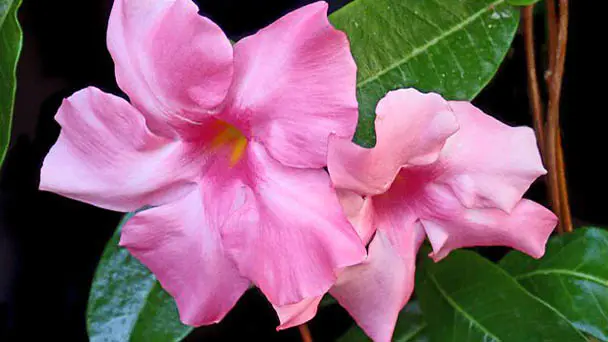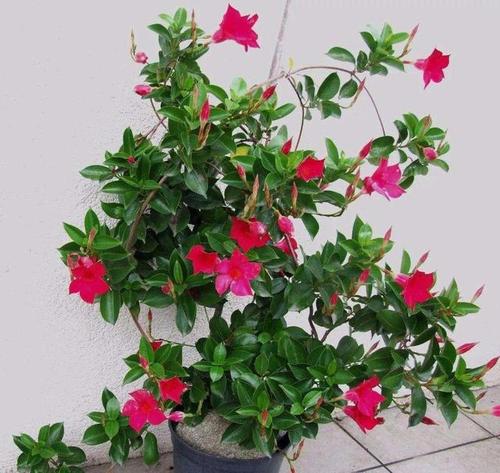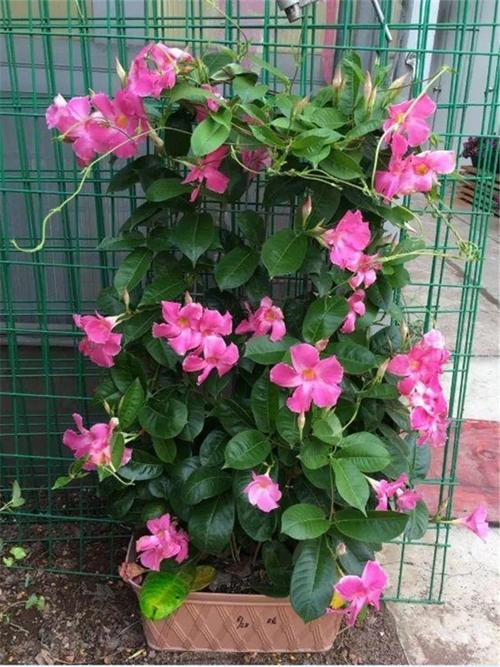How to Grow & Care for Mandevilla (Rocktrumpet)
Written by Maggie
Nov 24 2021

Mandevilla (Rocktrumpet) is a new type of vine, which looks like morning glory. During the flowering period, Mandevilla often presents a grand situation with more flowers than leaves. When the breeze hits, the faint fragrance makes people feel relaxed and happy. Many people want to grow this flower. This article will introduce Mandevilla care and growing.
Mandevilla Quick Info
| Botanical/Scientific Name | Mandevilla |
| Common Name | Rocktrumpet |
| Flower Bloom | Bloom continuously from late spring until frost |
| Uses | Seasonal patio plant |
| Origin | Forested and mountainous area in the vicinity of Rio de Janeiro |
| Light Care | Full sun |
| Soil Care | Sandy, well-draining soil |
| Temperature Care | Night temperatures of 60 to 65 °F and day temperatures above 70 °F |
| Humidity Care | Relative humidity falls below 50% |
| Watering | Water the plant at least once a week |
| Pruning Care | Never prune new growth vigorously |
| Fertilizer Care | High phosphorus, water soluble fertilizer once every two weeks |
| Propagation | Propagate from cuttings |
| Toxic | Won't cause severe poisoning |
| Flower Color | Pink, red, white |
Mandevilla Care in Detail
Soil care for growing Mandevilla
Mandevilla does not require a lot of soil, as it is highly adaptable. When we grow and care for Mandevilla, only the soil is rich in humus and the sandy soil is well drained.
Lighting care for growing Mandevilla
Mandevilla likes a sunny environment. As long as there is sufficient light, the normal growth and flowering of Mandevilla can be guaranteed. When we grow and care for Mandevilla, we can choose from half sunshine to full sunshine.
If not enough light will occur, then Mandevilla blooms with reduced amounts.
Watering care for growing Mandevilla
When we grow and care for Mandevilla, we must control the watering principle. When watering Mandevilla, please control the amount of watering, do not flood or dry, so that Mandevilla plant growth is not good.
Fertilization care for growing Mandevilla
When applying fertilizer to Mandevilla, flower lovers need to control the amount of nitrogen applied to prevent Mandevilla plants from flowering due to excessive growth due to high nutrition.
Temperature care for growing Mandevilla
The suitable temperature for Mandevilla growth is between 20 and 30℃, and the temperature of the general curing environment should not exceed 35℃. Frostbite is easy when the temperature is too low in winter. When we grow and care for Mandevilla, attention should be paid to maintaining the temperature in winter, preferably not less than 10℃.

Trimming care for growing Mandevilla
Mandevilla trimming usually takes two hours. When we grow and care for Mandevilla, trim after flowering and spring. Pruning after flowering can shape Mandevilla for a nice look. Pruning old plants in spring will encourage new shoots to sprout.
Mandevilla Repotting
The time of Mandeville repotting can be either in spring or after the flowers wither in autumn. Special attention should be paid to removing the pot. First remove the shelf or the hook on the edge of the pot, and then remove the plant from the pot. Properly trim the roots to cut off the unhealthy roots. We can choose the right flowerpot, fill it with loose sand, and then plant it, pour water into it, put it in the astigmatism, etc.
Mandevilla pests and disease
Mandevilla vines are no longer plagued by serious diseases, however they can turn out to be infested with whiteflies, spider mites or mealybugs. Examine your vine each and every few weeks to appear for bugs or larvae, and reduce off any diseased leaves or stems. If you see bugs, hose them off with a sturdy spray of water, or use an insecticidal cleaning soap or oil as directed on package deal labels. (Find more climb plants with flowers here.)

Mandevilla Winter Care
Mandevilla indoor winter care
How to care for Mandevilla in winter? Mandevilla will now not stay exterior if temperatures drop beneath 45 tiers in winter. In chillier climates, you can reflect on consideration of the plant annually and replant it each and every year. When we grow and care for Mandevilla, extend its lifestyle's exterior with the aid of transferring containers to the warmest spot in your yard or deck, commonly subsequent to the residence or a wall or close to concrete to replicate returned warmness on the plant. Or carry the vine indoors earlier than the first envisioned frost, and put it again backyard after the remaining frost is predicted. (Read more about Mandevilla Winter Care.)
Mandevilla dormant winter care
If you do not have room internally for your vine throughout the winter, you can save it in a basement or crawlspace where the place temperatures remain in the 55- to 60-degree range to ensure Mandevilla winter care. When we grow and care for mandevilla in winter, we should prune the stems back eight to 10 inches, and water the plant thoroughly. Then keep it in the cool, darkish vicinity and supply it solely sufficient water for it to continue to be alive, watering each three weeks or so. Once the vine sends up new shoots, cross it into the mild indoors, and set it outdoors as soon as all hazards of frost pass and temperatures attain above 60 levels at night. (Find more winter plants here.)
Mandevilla Propagation
Mandevilla Cutting Propagation
Mandeville needs to grow at a temperature of no less than 15 degrees. Therefore, the temperature of Mandeville cutting propagation should not be too low. If it is too low, it is not suitable for its branches and leaves and new rhizomes. It is best to reproduce in late spring, summer and autumn. The temperature of these three seasons is relatively moderate, so it is most suitable.
In order to make the propagated Mandeville cutting propagation grow better, it is also very important to select better branches. The best choice is the semi wooden branches newly grown in that year, with a length of about 21cm. Then, the selected branches can be stored in a bag with appropriate temperature, and their wounds can also be wrapped with toilet paper or wet cloth.
The step of cleaning pots and utensils is very important. Many people only care about how Mandeville cutting propagation propagates, but ignore this step. In order to be more conducive to the growth of Mandeville cutting propagation, we clean the container for cutting in order to remove the residual substances in it, Avoid infection of branches and wounds of Mandeville cutting propagation.
When selecting the substrate for Mandeville cutting propagation, pay attention to the soil with better humidity and breathable stars, which is conducive to the growth and development of rhizomes. Peat ash and perlite are good choices. Spray the selected substrate with water for standby. Remember to spray it with moderate humidity at the same time. Don't spray it too wet, We can try to hold a handful of soil in our hands. If the water is squeezed out, it is too wet. Such a matrix is not desirable for Mandeville cutting propagation.
Mandevilla Sowing Propagation
Mandeville sowing propagation is usually carried out in late spring and early summer. At this time, the temperature reaches 20 degrees, which is conducive to Mandeville's germination. The planting method of fragrant rattan can directly sow the seeds on the soil. After sowing, cover the seed surface with thin soil, and then pour enough water. Generally, wait until the seeds germinate and the seedlings grow 4-5 real leaves, We can transplant Mandeville seedlings.
When does Mandevilla Bloom&Harvest
Mandeville will bloom around April in spring, and the flowering period is relatively long, which can last until around October, that is, it can open for half a year. When Mandeville blooms, it has rich and diverse flower colors, such as red, peach and pink. The flowers are beautiful and scattered, which has a certain ornamental effect. If we want Mandeville to blossom better, we should provide a suitable environment for growth. We need to provide sufficient light, warm and suitable environment, as well as timely and correct pruning.
Mandevilla Benefits
It is an important role of Mandeville for people to watch. Its flowers are large and bright, and its plant shape is beautiful. It has the title of the king of tropical vines. Mandeville can be cultivated outdoors or potted indoors. Whether Mandeville is built into a roof or a fence, it can beautify the environment and provide people with viewing. In addition, when Mandeville is placed indoors, it can not only beautify the indoor environment, but also make the room full of aroma.
Mandeville is a plant with strong aroma. Its flowers contain a large amount of natural volatile oil, which can extract natural essential oil. After people use essential oil, it can refresh their minds and regulate their emotions.
Purifying the air is also one of the important functions of Mandeville. When placed indoors, it can absorb benzene and formaldehyde in the air, as well as some dust in the air, which can make people's indoor environment more pure. When Mandeville is planted outdoors, it has a certain adsorption on sulfur dioxide and other toxic components in the air, and has an obvious effect on purifying the environment.
Read Next:
10 Best Winter Plants to Brighten Your Winter Garden
Latest Updated
- Benefits of Bugleweed - 7 Science-backed Health Benefits
- Bugleweed Dangers & Side Effects - Is It Poisonous?
- How to Plant Evergreen Trees - What You Should Know
- When to Plant Evergreens - Grow Guide for Evergreen Trees
- 12 Wonderful Evergreen Shrubs for Your Garden
- 12 Popular Evergreen Plants with Pictures for Beginners
- When And How To Prune A Lilac Bush Like a Pro
- How to Grow & Care for Lilac Vine (Hardenbergia Violacea)
- Japanese Lilac Tree (Syringa Reticulata) Care & Propagation Guide
- Shumard Oak Pros and Cons - What to Know
Popular Articles
- Winter maintenance of Antirrhinum Majus
- How to Grow Terminalia Mantaly Tree
- How to Grow and Care for Crossostephium Chinense
- How to grow Antirrhinum Majus in spring
- Peristeria Elata (Dove Orchid) Profile: Info & Care Guide
- Underwatered Snake Plant (Sansevieria Trifasciata) - Signs And How To Fix
- How to Care for Brazilian Jasmine Plant (Mandevilla Sanderi)
- How to Grow & Care for Graptopetalum Purple Delight in Summer
- Rosa Chinensis (China Rose): Plant Growing & Care Tips
- How to Care for Baby Sun Rose (Aptenia Cordifolia)